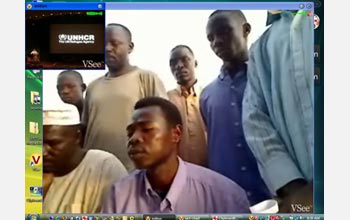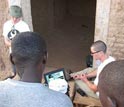News Release 09-124
Conflict Zones, Live
In recognition of World Refugee Day, 12 hours of live webcasts and chats will bring the world in touch with refugee camps around the world

A screen capture from an earlier VSee session from the newly named Obama school in Chad.
June 18, 2009
View videos of Milton Chen, chief technology officer at VSee, and Errol Arkilic, program manager in NSF's Division of Industrial Innovation and Partnerships.
This material is available primarily for archival purposes. Telephone numbers or other contact information may be out of date; please see current contact information at media contacts.
Refugees in global conflict zones often seem viscerally close in spirit, but tangibly remote. Now, for one day, the world will connect directly to refugees from Darfur, central Columbia and other sites in a 12-hour, live webcast.
Sponsored by the United Nations High Commissioner for Refugees (UNHCR) and delivered via the VSee communications platform--developed with the support of the U.S. National Science Foundation (NSF)--the event will bring world leaders, activists, media icons and legions of people from around the world into a day-long conversation with refugees and United Nations (UN) staffers.
From RefugeeDayLive.org, the webcast will link the world with the Djabal Camp in Eastern Chad and the Villavicencio, La Nora barrio, IDP settlement in central Columbia.
At the Web site, anyone can send texts, videos and other messages to refugees over the next several days and during the webcast on Saturday, June 20, 2009, starting at 9:00 a.m. EST. Throughout the webcast, visitors will interact with refugees and UN staff on-site and share their experiences.
Highlights include guided tours of the camps, a mother showing how she cooks refugee rations for her family, local dances and songs, and conversations with community elders about daily struggles.
"Traditional videoconferencing technology often breaks down due to the assumption of good infrastructure," says engineer Milton Chen, CEO of VSee and one of the developers of the technology. "Although we originally developed VSee for large enterprise global deployments to fit Intranet bandwidth limitations, the same approach turned out to enable communication with difficult-to-reach locations like refugee camps."
The VSee platform first drew broad public recognition during the U. S. Presidential Inauguration, when it linked the D.C. Metropolitan Police Department's numerous security cameras for real-time monitoring.
Though originally created as a telework platform, VSee adapted their system for security, and because the system shrank the cameras' data-streaming bandwidth to a fraction of its original size, even police cruisers were able to access the feeds via cellular networks.
The same capabilities enable VSee to link people from very limited bandwidth locations with anyone else in the world.
On June 20, VSee will connect with an Internet broadcast system, enabling a VSee videoconferencing session to be webcast to hundreds of thousands of people watching live. The audience will be able to ask questions of refugees using such tools as text chat and Twitter.
Developed with NSF support as part of the Small Business Innovation Research Program, VSee originally emerged as Chen's doctorate work at Stanford University, where he focused on videoconferencing and remote collaboration.
Dissatisfied with existing virtual office platforms, Chen hoped to maintain the advantages of telework while shedding its technical shortfalls and impact on office social dynamics.
The current application is the latest for a technology that has evolved far beyond its initial development. For more on the system, including video interviews with Chen and NSF program officer Errol Arkilic, see Keeping an Eye on the Inauguration at: http://www.nsf.gov/news/news_summ.jsp?cntn_id=114128.
-NSF-
-
View Video
Milton Chen of VSee explains how the system works and how it differs from existing applications.
Credit and Larger Version -
View Video
Errol Arkilic describes the VSee technology and role of federal investments for small-business R&D.
Credit and Larger Version -
The setup for an earlier VSee connection between an overseas audience and the Obama school.
Credit and Larger Version
Media Contacts
Joshua A. Chamot, NSF, (703) 292-7730, email: jchamot@nsf.gov
Program Contacts
Errol B. Arkilic, NSF, (703) 292-8095, email: earkilic@nsf.gov
Principal Investigators
Milton Chen, VSee, (650) 400-1798, email: milton@vsee.com
The U.S. National Science Foundation propels the nation forward by advancing fundamental research in all fields of science and engineering. NSF supports research and people by providing facilities, instruments and funding to support their ingenuity and sustain the U.S. as a global leader in research and innovation. With a fiscal year 2023 budget of $9.5 billion, NSF funds reach all 50 states through grants to nearly 2,000 colleges, universities and institutions. Each year, NSF receives more than 40,000 competitive proposals and makes about 11,000 new awards. Those awards include support for cooperative research with industry, Arctic and Antarctic research and operations, and U.S. participation in international scientific efforts.
Connect with us online
NSF website: nsf.gov
NSF News: nsf.gov/news
For News Media: nsf.gov/news/newsroom
Statistics: nsf.gov/statistics/
Awards database: nsf.gov/awardsearch/
Follow us on social
Twitter: twitter.com/NSF
Facebook: facebook.com/US.NSF
Instagram: instagram.com/nsfgov



